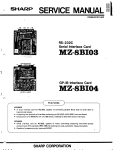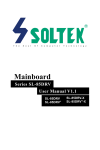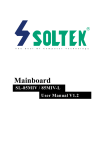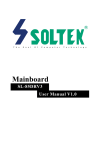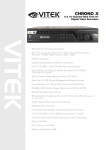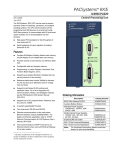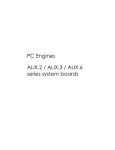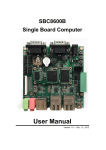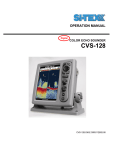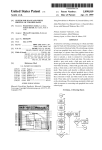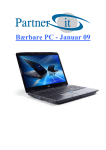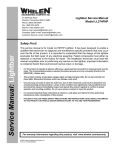Download Mainboard - Elhvb.com
Transcript
R T h e S o u l O f C o m p u t e r T e c h n o l o g y Mainboard SL-85DRS2 User Manual V1.0 85DRS2 Product Model Manual Revision Release Date : SL-85DRS2 : V1.0 : December 2001 NOTICE This Users Guide & Technical Reference is to help system manufacturers and end-users set up and install the mainboard.Every effort has been made to ensure that the information in this manual is accurate. Soltek Computer Inc. is not responsible for printing or clerical errors. Information in this document is subject to change without notice and does not represent a commitment on Soltek Computer Inc. No part of this manual may be reproduced, transmitted, translated into any language in any form or by any means, electronic or mechanical, including photocopying and recording, for any purpose without the express written permission of Soltek Computer Inc. Companies and products mentioned in this manual are for identification purpose only. Product names appearing in this manual may or may not be registered trademarks or copyrights of their respective companies. Soltek Computer Inc. provides this manual “as is “ without warranty of any kind, either express or implied, including but not limited to the implied warranties or conditions of merchantability or fitness for a particular purpose. In no event shall Soltek Computer Inc. be liable for any loss or profits, loss of business, loss of use or data, interruption of business, or for indirect, special, incidental, or consequential damages of any kind, even if Soltek Computer Inc. has been advised of the possibility of such damages arising from any defect or error in this manual or product. • Intel Pentium 4 is trademark of Intel Corporation. • SiS, SiS 645 (A2), SiS 961 are trademarks of Silicon Integrated Systems Corporation. • AMI, AMIBIOS are trademarks of American Megatrends Inc. • ITE, IT8705F are trademarks of Integrated Technology Express, Inc. Copyright © 2001 Soltek Computer Inc. All Rights Reserved. 2 85DRS2 SOLTEK AROUND THE WORLD SOLTEK COMPUTER INC. Address Telephone Fax E-mail Web site : 7F, No. 306-3, Ta-Tung Rd, Sec.1, Hsi-Chih, TaipeiHsien, Taiwan, R.O.C. : 886-2-2642-9060 : 886-2-2642-9065 : [email protected] : http://www.soltek.com.tw SOUL TECHNOLOGY EUROPE B.V. Address Telephone Fax E-mail Web site : Hongkongstraat 55, 3047 BP Rotterdam. The Netherlands : 31-10-2457492 : 31-10-2457493 : [email protected] : http://www.soultech-europe.com SOLTEK KOREA INC. Address Telephone Fax E-mail : 1002, Chung Jin Bldg. 53-5 Wonhyo-Ro, 3-Ka, Yongsan-Ku Seoul 140-113, Korea : 82-2-32717400 : 82-2-32717405 : [email protected] 3 Contents Contents Chapter 1 Specification ............................................. 9 1-1 Main board Layout and Component Locations: .............. 10 1-2 Mainboard Specifications ..................................................... 11 1-2.1 CPU Socket ................................................................................... 11 1-2.2 System Chipsets ........................................................................... 11 1-2.3 Memory ......................................................................................... 11 1-2.4 AMI BIOS V2.01A ....................................................................... 11 1-2.5 Accelerated Graphics Port (AGP) Interface ........................... 11 1-2.6 Advanced System Power Management: .................................. 12 1-2.7 Multi-I/O Functions: ................................................................... 12 1-2.8 Expansion Slots ............................................................................ 12 1-2.9 Hardware Monitor on board ..................................................... 13 1-2.10 AC’97 Audio Codec on board ................................................. 13 1-2.11 Form Factor ................................................................................ 13 1-3 Mainboard Specification Table ........................................... 14 1-4 Chipset System Block Diagram ........................................... 15 Chapter 2 Hardware Setup ..................................... 17 2-1 CPU Installation with Socket 478 ....................................... 18 2-2 Install Pentium 4 CPU Fan and Fan Connector : ............ 19 2-3 Memory Installation ............................................................. 20 2-3.1 To Install DDR SDRAM Module for this Mainboard : ........ 20 2-3.2 To Remove a DIMM: ................................................................... 21 2-3.3 Indicator D7 for DIMM Socket Power On: ............................ 21 2-4 AGP (Accelerated Graphics Port) Installation: ............... 22 4 Contents 2-5 HDD Installation .................................................................... 23 2-6 Flopy Disk Drive (FDD) Installation .................................. 24 2-7 ATX V 2.03 Power Supply Installation .............................. 25 2-8 Jumper and Switch Settings ................................................ 26 2-8.1 Switch S3 for CPU Clock Select ................................................ 27 2-8.2 Jp10 Clear CMOS ...................................................................... 28 2-8.3 Jp2 & Jp3 DIMM Voltage Select: ............................................ 28 2-9 Other Connectors Configuration ........................................ 29 2-9.1 On Board FAN Connectors ........................................................ 29 2-9.2 WOL1 Wake On LAN Connector ............................................. 30 2-9.3 Connector Video-In ..................................................................... 30 2-9.4 CD-ROM Audio Connectors (CD_In1/CD_In2) .................... 31 2-9.5 Chassis Panel Connectors ......................................................... 31 2-9.6 Thermal Sensor Connectors RT1 and RT2 ............................. 32 2-9.7 Complex Header .......................................................................... 33 2-9.8 USB Ports and USB Header (Header USB 2) ......................... 35 2-9.9 PS/2 Mouse And PS/2 Keyboard ............................................... 35 2-10 IRQ Description ................................................................... 36 Chapter 3 Software Setup ....................................... 38 3-1 Open up Support CD: ........................................................... 39 3-2 Proceed to INF Driver Installation ..................................... 40 3-3 Proceed to AC’97 Audio Driver Installation ..................... 41 3-4 Proceed to Hardware Monitor Installation ..............................42 Chapter 4 BIOS Setup ............................................. 44 4-1 About BIOS Setup ................................................................. 45 4-2 To run BIOS Setup ................................................................ 45 4-3 About CMOS .......................................................................... 45 4-4 The POST ( Power On Self Test ) ....................................... 45 5 Contents 4-5 To upgrade BIOS ................................................................... 46 4-5.1 Before Upgrading BIOS ............................................................. 46 4-5.2 Upgrade Process ........................................................................... 46 4-6 BIOS SETUP --- CMOS Setup Utility ................................ 48 4-6.1 CMOS Setup Utility .................................................................... 48 4-6.2 Standard CMOS Setup ............................................................... 49 4-6.3 Advanced BIOS Features ........................................................... 52 4-6.4 Advanced Chipset Features ....................................................... 55 4-6.5 Power Management Setup ......................................................... 57 4-6.6 PNP / PCI Configuration ............................................................ 60 4-6.7 Integrated Peripherals ................................................................ 62 4-6.8 PC Health Status .......................................................................... 65 4-6.9 Frequency/Voltage Control ....................................................... 67 4-6.10 Set Supervisor / User Password ............................................. 69 4-6.11 Load Optimized Defaults ........................................................ 71 4-6.12 Save & Exit Setup ...................................................................... 71 4-6.13 Exit Without Saving .................................................................. 72 APPENDICES .......................................................... 74 Appendix-1 Identify Mainboard Model Number ................... 75 Appendix-2 Technical Terms ...................................................... 76 6 Contents 7 85DRS2 ITEM CHECKUP Mainboard Support CD Bundled Bonus Pack CD Bundled Bonus Pack Manual Temperature Sensor Cable (Optional) ATA66/100 IDE Cable FDD Cable User Manual RS232 Cable 8 Chapter 1 Specification Chapter 1 Specification Introduction This mainboard features an integration of the powerful processor Intel Pentium 4 and the single-chip North Bridge SiS 645 (A2 version). The Intel P4 processor is a rapid execution engine providing 400MHz quadpumped system bus to allow 3.2GB data transfer rates possible, while North Bridge SiS 645 (A2) is an upgraded version of SiS 645 for further advancing the performace of DRAM, 3D Graphics and the whole system. Together with South Bridge SiS 961, SiS 645 (A2) supports Intel P4 processor to execute the 400MHz FSB, the AGP 4X external bus, the LPC Super I/O and the DDR SDRAM data transfer. This chapter is to introduce to users every advanced function of this high performance integration. Topics included in this chapter are: 1-1 Mainboard Specifications 1-2 Mainboard Layout 1-3 Mainboard Specification Table 1-4 Chipset Diagram 9 85DRS2 1-1 Main board Layout and Component Locations: D7 PS/2 Mouse (on top) DIMM Indicator FAN1 PS/2 K/B (underside) 1 USB0 (on top) mPGA478B 1 DDR 333 COM2 COM1 LPT1 USB1 (underside) 1 FAN2 1 Peripheral 3 1 +12V Power SiS 645 (A2) Main Power Jp3 AGP 4X/2X DIP S3 Jp2 1 2 3 4 5 1 RT1 1 FAN3 1 PCI 1 DIMM 3 CD_IN1 ON DIMM 2 Switch DIMM 1 GAME/MIDI PORT 1 1 CD_IN2 1 IDE1 SiS 961 1 FDC IR PCI 5 PCI 6 IT8705F LPC I/O 16 1 USB 2 1 10 RST WOL1 HDD/LED 1 PWR SMI RT2 30 PCI 4 Jp10 1 FAN4 FLASH BIOS SUS LED PCI 3 PWR LED AC'97 Audio 1 IDE2 PCI 2 SPK Video-In Li Battery MIC LINE LINE IN OUT 1 Chapter 1 Specification 1-2 Mainboard Specifications 1-2.1 CPU Socket CPU Socket 478B on board, supporting Intel® Pentium 4 processors in 478-pin package for : -- 400MHz System Bus; -- Hyper pipelined technology; -- Advanced dynamic execution; -- Advanced transfer cache; 1-2.2 System Chipsets North Bridge SiS 645 (A2) (advanced version of SiS 945) plus South Bridge SiS 961 working with Intel Pentium 4 Processor for managing and arbitrating operations between all system interfaces: 1-2.3 Memory 3 DDR DIMM 184-pin sockets on board for DDR333/266/200 SDRAMs, supported by 2.5V default voltage : • Supporting unbuffered SDRAM transfer rate 100/133/166MHz up to 3GB DDR266/200 SDRAMs in 3 DIMMs or 2GB DDR333 in 2 DIMMs • Supporting installation of mixed volumes yet same type of DDR SDRAM modules 1-2.4 AMI BIOS V2.01A • • • • Supporting Plug & Play V1.0 Flash Memory for easy upgrade Supporting BIOS Writing Protection and Year 2000 compliant Supporting BIOS Setup (Please see Chapter 4 BIOS Setup) 1-2.5 Accelerated Graphics Port (AGP) Interface AGP Controller embedded, supporting: • 1.5V/4X, 3.3V/2X power mode , AGP voltage selectable in BIOS Setup • 2x/ 4x AD and SBA signalling, AGP pipelined split-transection longburst transfers up to 1GB/sec. • AGP v2.0 compliant 11 85DRS2 1-2.6 Advanced System Power Management: • ACPI 1.0B compliant (Advanced Configuration and Power Interface) • APM V1.2 compliant (Legacy power management) • ACPI STR mode (Suspend To RAM) , POS (Power On Suspend) and STD (Suspend to Disk) • PS/2 Keyboard & Mouse power on • Supporting Ring Power Up Control for Wake-on-Modem (external) and Wake-on-LAN • Real Time Clock (RTC) with date alarm, month alarm, and century field • USB wake-up Function; 1-2.7 Multi-I/O Functions: • PCI EIDE Controller, supporting: -- 2x Ultra ATA100 / 66 / 33 IDE connectors supporting up to 4 IDE devices • Dedicated IR Functions: -- Third serial port dedicated to IR function either through the two complete serial ports or the third dedicated port Infrared-IrDA (HPSIR) and ASK (Amplitude Shift Keyed) IR • Multi-mode parallel Data transfer: -- Standard mode, ECP and EPP support • Floppy Disk connector: -- One FDD connector with drive swap support • Universal Serial Bus Transfer Mode: -- USB V1.1 compliant; -- 2 built-in USB connectors and one USB Header (USB2) which requires an optional USB cable to provide 2 more optional USB ports • PS/2 Keyboard • PS/2 Mouse • UARTs (Universal Asynchronous Receiver / Transmitter): -- Two complete Serial Ports (COM1 & COM2) on board 1-2.8 Expansion Slots • Six PCI bus Master slots • One AGP 4x/2X slot • Three DDR DIMM slots 12 Chapter 1 Specification 1-2.9 Hardware Monitor on board Programmable hardware status to provide monitoring and alarm for flexible desktop management of hardware temperatures. Utility Software is enclosed in Support CD to help display monitoring statuses of: -- 6 voltages, 3 hardware temperatures, 2 Fan speeds 1-2.10 AC’97 Audio Codec on board AC’97 Audio codec on board supported by AC97 Link on chip SiS 961 1-2.11 Form Factor • ATX form factor, ATX power supply, version 2.03 compliant, supported by one Main Power Connector, one +12V Power Connector and one Peripheral Power Connector • Mainboard size: 305mm x 225mm 13 85DRS2 1-3 Mainboard Specification Table Model CPU SL-85DRS2 Socket PGA 478B for Intel Pentium 4 CPU Memory Controller Hub SiS 645 (A2 version) I/O Controller Hub SiS 961 BIOS AMI BIOS I/O Chip IT 8705F Memory Supporting DDR333/266/200 SDRAM up to 3GB 3 DIMM Slots Onboard IDE I/O Connectors PCI slot AGP Interface Audio 2 x ATA 33/66/100 IDE ports 4 x USB ports, 1 x FDD port, 2 x COM ports, 1 x LPT port, 1 IrDA, 1 PS/2 Mouse, 1 PS/2 K/B 6 PCI Master Slots AGP 4X Mode AC'97 Audio Codec Hardware¤ Monitoring Power Supply Yes ATX 2.03 form factor with one Main power Connector one Peripheral Power Connector one +12V Power Connector BIOS writing Protection Yes Keyboard power on function & USB wake up Function Yes Remark 14 Chapter 1 Specification 1-4 Chipset System Block Diagram Intel Pentium 4 Processor System Bus (4x100MHz) Bandwidth 3.2GB/s with 2X address/4X data DDR Memory Interface AGP 4x (1.5V) AGP Graphics SiS 645 (A2) -System Bus -Memory Controller DDR333/266/ 200 SDRAM System Memory -AGP Controller Bi-directional 15-bit data bus, at 266MHz operating frequency, 533MH/s bandwidth HDD CD-ROM PCI Slots PCI Bus ATA100/66/33 SiS 961 USB Ports USB Bus IR FD Mouse Keyboard Serial Ports Printer Port Game/MIDI I/O Control Hub AC'97 2.1 Audio Codec LPC I/O Chip IT8705F BIOS Intel Pentium 4 + SiS 645 (A2) + SiS 961 Diagram 15 85DRS2 MEMO MEMO 16 Chapter 2 Hardware Setup Chapter 2 Hardware Setup To Get things ready for Hardware setup ! 1. We recommend to install your CPU before any other components. For detailed installation instructions of processor, you can also refer to the pamphlet enclosed in your CPU package. 2. Installing a cooling fan with a good heatsink is a must for proper heat dissipation for your CPU. Get ready an appropriate fan with heatsink for proper installation. Improper fan and installation will damage your CPU. 3. In case CPU Vcore, CPU clock or Frequency Ratio is adjustable on board, please follow the instructions described in the User manual for proper setup. Incorrect setting will cause damage to your CPU. The following topics are included in this chapter: 2-1 Pentium 4 CPU Installation 2-2 Pentium 4 CPU Fan Installation 2-3 Memory Installation 2-4 HDD Installation 2-5 FDD Installation 2-6 AGP (Accelerated Graphic Port) Installation 2-7 ATX 2.03 Power Supply Installation 2-8 Jumper Settings for Devices on board 2-9 Other Connectors Configuration 2-10 IRQ Description 17 85DRS2 2-1 CPU Installation with Socket 478 This mainboard is built with CPU Socket 478 ( 47-pin) supporting the Intel Pentium 4 CPU: • Follow the steps described in this section to install the 478-pin Pentium 4 CPU into the on board Socket 478. • After installation of Pentium 4 CPU, you must also install the specific Pentium 4 CPU fan designed in tandem with this CPU. This CPU Fan installation is described in next section. m PG A 47 8B 1. First pull sideways the lever of Socket 478, and then turn it up 900 so as to raise the upper layer of the socket from the lower platform. Pin 1 Inte m PG A4 78 B l Pe ntiu m4 2. Configure Pin 1 of CPU to Pin 1 of the Socket, just as the way shown in the diagram on the left. Adjust the position of CPU until you can feel all CPU pins get into the socket with ease. Pin 1 Intel Pentium 4 mPGA478B 3. Make sure that all CPU pins have completely entered the socket and then lower down the lever to lock up CPU to socket. Pin 1 18 Chapter 2 Hardware Setup 2-2 Install Pentium 4 CPU Fan and Fan Connector : CPU Fan Connector Pentium 4 Fanbase Connect CPU FAN connector to CPU Fan Press down latches to lock fan to fanbase 19 85DRS2 2-3 Memory Installation How to tackle with the memory Modules: • Make sure to unplug your power supply before adding or removing memory module. Failure to do so may cause severe damage to both your main board and the memory module. • Pay attention to the orientation of the DIMM slots. Forcing a DIMM in a socket improperly will damage the memory module and socket. • Make sure you have the right type of memory module for your mainboard. 2-3.1 To Install DDR SDRAM Module for this Mainboard : 1. This mainboard only supports unbuffered DDR SDRAM. Do not insert other type of DDR SDRAM therein. 2. For DDR333, this mainboard can support up to 2GB memory in two DIMMs.That is, you can only use 1 or 2 DDR333 SDRAM modules. 3. For DDR266/200, this mainboard can support up to 3 GB memory in 3 DIMMs. 4. DDR DIMM socket has 184 pins and one notch. Insert a DDR SDRAM vertically into the 184-pin socket with its notch matching the one in the socket. Press the Module down in a gradual way until it surely reaches the bottom and clicks straight up the two latches on the left and right side of the socket. If any one of the latches has not turned up completely, you should unplug the module and press it down the socket a bit more firmly. 184-Pin DIMM Notch Key Definitions (2.5V) DRAM Key Position Voltage Key Position 2.5V Module Latch 20 Chapter 2 Hardware Setup 2-3.2 To Remove a DIMM: Press down the holding latches on both sides of socket and the module will be released from the DIMM socket. 2-3.3 Indicator D7 for DIMM Socket Power On: An indicator D7 is designed on board. Whenever system is started or is in STR status (Suspend to RAM), all the DIMM sockets on board will also get powered on with the set voltage, resulting in D7 lighting up. This indicator D7 is to warn users that, whenever DIMM socket is powered, no memory module should be removed from or added into it. DIMM Power On Indicator D7 D7 PS/2 Mouse (on top) DIMM Indicator FAN1 PS/2 K/B (underside) 1 USB0 (on top) mPGA478B 1 DDR 333 COM2 COM1 LPT1 USB1 (underside) 1 FAN2 1 Peripheral 3 1 +12V Power SiS 645 (A2) Main Power Jp3 AGP 4X/2X S3 Jp2 1 RT1 1 FAN3 1 PCI 1 DIMM 3 DIP 1 2 3 4 5 DIMM 2 ON DIMM 1 Switch CD_IN1 1 1 CD_IN2 1 IDE1 SiS 961 1 FDC PCI 5 PCI 6 IT8705F LPC I/O RST IR WOL1 HDD/LED 1 PWR SMI RT2 30 PCI 4 SUS LED PCI 3 PWR LED AC'97 Audio 1 IDE2 PCI 2 SPK Video-In Li Battery LINE LINE IN OUT MIC GAME/MIDI PORT 1 16 1 USB 2 1 Jp10 1 FAN4 FLASH BIOS DDR DIMM Sockets (184-pin) 21 85DRS2 2-4 AGP (Accelerated Graphics Port) Installation: The AGP slot on board supports 4X / 2X AGP card configuration. User can install either a 4X or 2X AGP card. AGP Accelerator AGP 4X / 2X D7 PS/2 Mouse (on top) DIMM Indicator FAN1 PS/2 K/B (underside) 1 USB0 (on top) mPGA478B 1 DDR 333 COM2 COM1 LPT1 USB1 (underside) 1 FAN2 1 Peripheral 3 1 +12V Power SiS 645 (A2) Main Power Jp3 AGP 4X/2X S3 Jp2 1 2 3 4 5 1 RT1 1 FAN3 1 PCI 1 DIMM 3 DIP DIMM 2 CD_IN1 ON DIMM 1 Switch 1 1 CD_IN2 1 IDE1 SiS 961 1 FDC PCI 6 IT8705F LPC I/O 16 1 USB 2 1 22 RST IR PCI 5 HDD/LED WOL1 PWR SMI RT2 1 30 PCI 4 Jp10 1 FAN4 FLASH BIOS SUS LED PCI 3 PWR LED AC'97 Audio 1 IDE2 PCI 2 SPK Video-In Li Battery LINE LINE IN OUT MIC GAME/MIDI PORT 1 Chapter 2 Hardware Setup 2-5 HDD Installation To install HDD (Hard Disk Drive), you may connect the connector of IDE cable to the primary (IDE1) or secondary (IDE2) connector on board, and then connect the gray connector to your slave device and the black connector to your master device. If you install two hard disks, you must configure the second drive to Slave mode by setting its jumpers correctly. Please refer to your hard disk documentation for the jumper settings. D7 PS/2 Mouse (on top) DIMM Indicator FAN1 PS/2 K/B (underside) 1 USB0 (on top) mPGA478B 1 DDR 333 COM2 COM1 LPT1 USB1 (underside) 1 FAN2 IDE2 1 Peripheral 3 1 +12V Power (A2) Main Power Jp3 AGP 4X/2X DIP S3 Jp2 1 2 3 4 5 1 RT1 1 FAN3 1 PCI 1 1 DIMM 3 ON DIMM 2 Switch CD_IN1 1 CD_IN2 1 IDE1 SiS 961 1 FDC 30 PCI 4 PWR SMI RT2 PCI 5 Pin 1 (to Red Line) RST IT8705F LPC I/O HDD/LED PCI 6 Li Battery IR WOL1 Hard Disk Drive Connector: Orient the red line on the IDE ribbon cable to Pin1. SUS LED PCI 3 PWR LED AC'97 Audio 1 IDE2 PCI 2 SPK Video-In 1 IDE1 SiS 645 DIMM 1 LINE LINE IN OUT MIC GAME/MIDI PORT 1 16 1 USB 2 1 Jp10 1 FAN4 FLASH BIOS Gray connector Black connector red line Blue connector IDE Cable 23 85DRS2 2-6 Flopy Disk Drive (FDD) Installation To install FDD (Floppy Disk Drive), you should connect the end of the cable with single connector to the board , and connect the other end with two connectors to the floppy drives. D7 PS/2 Mouse (on top) DIMM Indicator FAN1 PS/2 K/B (underside) 1 USB0 (on top) mPGA478B 1 FAN2 1 Floppy Disk Drive Connector: Orient the red line on the floppy ribbon cable to Pin1. DDR 333 COM2 COM1 LPT1 USB1 (underside) 1 Peripheral 3 1 +12V Power SiS 645 (A2) Main Power Jp3 AGP 4X/2X 1 RT1 1 FAN3 1 Pin 1 (to Red Line) Jp2 PCI 1 1 DIMM 3 S3 1 2 3 4 5 DIMM 2 DIP DIMM 1 Switch CD_IN1 ON 1 CD_IN2 1 IDE2 1 IDE1 SiS 961 1 FDC 30 PCI 4 PCI 5 IR WOL1 PWR SMI RT2 1 FDC RST HDD/LED PCI 6 IT8705F LPC I/O SUS LED PCI 3 PWR LED PCI 2 SPK Video-In AC'97 Audio Li Battery LINE LINE IN OUT MIC GAME/MIDI PORT 1 16 1 USB 2 1 Jp10 1 FAN4 FLASH BIOS To 2nd Floppy Drive red line To 1st Floppy Drive FDD Cable 24 To mainboard Chapter 2 Hardware Setup 2-7 ATX V 2.03 Power Supply Installation D7 PS/2 Mouse (on top) DIMM Indicator FAN1 PS/2 K/B (underside) 1 USB0 (on top) mPGA478B 1 FAN2 1 +12V Power Connector (4-pin) DDR 333 COM2 COM1 LPT1 USB1 (underside) 1 Peripheral 3 1 +12V Power SiS 645 (A2) Main Power Jp3 DIP S3 1 2 3 4 5 1 RT1 1 FAN3 1 PCI 1 DIMM 3 ON Jp2 DIMM 2 Switch CD_IN1 AGP 4X/2X DIMM 1 LINE LINE IN OUT MIC GAME/MIDI PORT 1 1 1 +12V 4 3 +12V GND 2 1 GND CD_IN2 1 IDE1 SiS 961 1 FDC 30 PCI 4 PCI 5 16 1 USB 2 1 Peripheral Power Connector (4-pin) Pin 1 Pin 4 RST IT8705F LPC I/O HDD/LED PCI 6 Li Battery IR WOL1 PWR SMI RT2 1 Jp10 1 FAN4 SUS LED PCI 3 PWR LED AC'97 Audio 1 IDE2 PCI 2 FLASH BIOS +12V GND GND +5V SPK Video-In PIN1 +12V 5SB PWR_OK GND +5V GND +5V GND +3.3V +3.3V Pin11 +5V +5V -5V GND GND GND PS_ON# GND -12V +3.3V Main Power Connector (20-pin) Intel Pentium 4 requires power support of ATX V2.03. To set up ATX2. 03 Power Supply on this mainboard, Please take the following steps: 1. Connect the on-board Main Power Connector (20-pin) to the Main Power Connector (20-pin) of an ATX Power Supply which can be either of the latest version 2.03 or of earlier ATX format. 2. If you use an ATX Power Supply Version 2.03 or later, you can now connect the on-board square-shaped +12V Connector to the squareshaped +12V Connector of your ATX Power Supply. In this case, it is not necessary for you to connect the on-board 4-pin Peripheral Power Connector to your Power Supply. 3. If you use an ATX power Supply of a version earlier than V2.03, you cannot find a square-shaped +12V Connector with your Power Supply; you must then connect the on-board 4-pin Peripheral Power Connector to the 4-pin Peripheral Power Connector of your Power Supply. 25 85DRS2 2-8 Jumper and Switch Settings The following diagrams show the locations and settings of Switch and jumper blocks on the mainboard. Jp2 & Jp3 DIMM Voltage Select DIMM 2.5VJ 2.6VJ 2.7VJ 2.8VJ Voltage (default) Jp2J Jp3J Jp2J Jp3J Jumper Setting 1J 1J 1J 1-2J 1-2J closedJ 1J Jp2J Jp3J 1J 1J Jp2J Jp3J 1J 1-2J 2-3 J 2-3 J 1-2J closedJ closedJ 1J 2-3 J 2-3 J closedJ D7 PS/2 Mouse (on top) DIMM Indicator FAN1 PS/2 K/B (underside) 1 USB0 (on top) mPGA478B 1 DDR 333 COM2 COM1 LPT1 USB1 (underside) 1 FAN2 Jp10 Clear CMOS 1 Peripheral 3 1 +12V Power SiS 645 1 2-3 closed (A2) Main Power Jp3 S3 Jp2 1 2 3 4 5 CD_IN1 1 RT1 1 FAN3 1 PCI 1 DIMM 3 DIP DIMM 2 ON DIMM 1 Switch AGP 4X/2X 1 To clear CMOS 1 CD_IN2 IDE2 1 FDC 30 PCI 4 PCI 5 IR WOL1 PCI 6 16 1 USB 2 1 S3 On RST IT8705F LPC I/O HDD/LED 1 PWR SMI RT2 SUS LED SiS 961 1 1 IDE1 PCI 3 PWR LED PCI 2 1-2 closed (default) Normal status 1 SPK Video-In AC'97 Audio Li Battery LINE LINE IN OUT MIC GAME/MIDI PORT 1 Jp10 1 FAN4 FLASH BIOS DIP ON CPU Clock Select Off 1 2 34 5 On On Off Off Off (Default) DDR type DDR266 DDR333 CPU Clock S3-1 (MHz) default 100 on 105 108 112 133 100 133 off off off off on on S3-2 S3-3 S3-4 S3-5 on off off off off off off on on on off off off off on on on on on off off off off on on on off on 26 Chapter 2 Hardware Setup How to tackle with Jumpers: • Do not remove the jumper when power is on. Always make sure the power is off before changing any jumper settings. Otherwise, mainboard could be damaged. • In the Jumper setting diagram, all jumper pins covered with black marks stand for closed pins by jumper caps. 2-8.1 Switch S3 for CPU Clock Select 1. This mainboard is shipped to users with a 5-DIP Switch on board, by which user can select a CPU clock to match with the Pentium 4 processor installed on board. Yet users are not recommended to take Switch S3 as a foolproof tool for overclocking. Instead, it is saver and more advisable to select the CPU clock as near as possible to the one marked on the selected CPU. 2. An Advice from our Engineering Team: CPU Overclocking should always take the on-board components into account. If you are using DDR266 SDRAM on this mainboard, you must not set the switch S3 to the DDR333 settings; otherwise you risk system damage. S3 On DIP ON CPU Clock Select Off 1 2 34 5 On On Off Off Off (Default) DDR type DDR266 DDR333 CPU Clock S3-1 (MHz) default 100 on 105 108 112 133 100 133 off off off off on on S3-2 S3-3 S3-4 S3-5 on off off off off off off on on on off off off off on on on on on off off off off on on on off on 27 85DRS2 2-8.2 Jp10 Clear CMOS When you have problem with rebooting you system, you can clear CMOS data and restore it to default value. To clear CMOS with Jumper Jp10, please follow the steps below: 1. Power off system; 2. Set JBAT1 to Pin 2-3 closed. 3. After 2 or 3 seconds, return the JBAT1 setting to Pin1-2 closed. 4. CMOS data are restored to default. Remember never clear CMOS when system power is on. Jp10 Clear CMOS 1 2-3 closed To clear CMOS 1-2 closed (default) Normal status 1 2-8.3 Jp2 & Jp3 DIMM Voltage Select: The default voltage 2.5V at DIMM sockets is for normal operation of the supported DDR SDRAM. In some case, when you try to do CPU overclocking, you then may also need to raise the transfer rate of the memory interface. Jp2 & Jp3 are designed on board to provide settings for selecting a higher DIMM voltage so as to raise the speed of the memory interface. Warning: In selecting a higher voltage than the default one, you are risking the stability of your system. Jp2 & Jp3 DIMM Voltage Select DIMM 2.5VJ 2.6VJ 2.7VJ 2.8VJ Voltage (default) Jp2J Jp3J Jp2J Jp3J Jumper Setting 1J 1J 1-2J 1-2J closedJ 1J 1J Jp2J Jp3J 1J 1J 1-2J 2-3 J 2-3 J 1-2J closedJ closedJ 28 Jp2J Jp3J 1J 1J 2-3 J 2-3 J closedJ Chapter 2 Hardware Setup 2-9 Other Connectors Configuration This section lists out all connectors configurations for users’ reference. 2-9.1 On Board FAN Connectors D7 PS/2 Mouse (on top) DIMM Indicator FAN1 PS/2 K/B (underside) 1 USB0 (on top) mPGA478B 1 DDR 333 COM2 COM1 LPT1 USB1 (underside) 1 FAN2 CPU FAN Connector FAN1, yellow, sensor 1 Peripheral 1 +12V Power SiS 645 (A2) Main Power Jp3 AGP 4X/2X DIP S3 Jp2 1 2 3 4 5 1 RT1 1 FAN3 1 PCI 1 DIMM 3 ON DIMM 2 Switch CD_IN1 DIMM 1 LINE LINE IN OUT MIC GAME/MIDI PORT 1 3 GND +12V SENSOR 1 1 Power FAN Connector FAN2, no sensor CD_IN2 1 IDE1 PCI 3 SiS 961 1 FDC PCI 5 RST System FAN Connector FAN4, no sensor SPK IT8705F LPC I/O HDD/LED PCI 6 Li Battery IR WOL1 PWR SMI RT2 1 30 PCI 4 AGP FAN Connector FAN3, yellow, sensor SUS LED AC'97 Audio 1 IDE2 PCI 2 PWR LED Video-In 16 1 USB 2 1 Jp10 1 FAN4 FLASH BIOS These fan connectors support CPU/Power/AGP/System cooling fan with +12V. When connecting the wire to FAN connectors, users should make sure that the red wire is for the positive current and should be connected to pin +12V, and the black wire is Ground and should be connected to pin GND. If your mainboard has Hardware Monitor chipset on board, you must use a specially designed fan with speed sensor to take advantage of the monitoring function. For fans with speed sensors, each rotation of the fan blades will send out 2 electric pulses, by which System Hardware Monitor will work out the fan rotation speed by counting the pulses. NOTE : 2 “Yellow” fan connectors are used on this series to mark that they support fan speed sensor function. The other two white fan connectors do not support sensor function. 29 85DRS2 2-9.2 WOL1 Wake On LAN Connector 1. This connector connects to a LAN card with a Wake On Ring output. The connector powers up the system when it receives a wake-up packet or signal through the LAN card. 2. This feature requires that Ring Power Up Control feature is enabled in the BIOS setting “Power Management Setup” and that your system must be on ATX power supply with at least 720mA / +5V standby power. D7 PS/2 Mouse (on top) DIMM Indicator FAN1 PS/2 K/B (underside) 1 USB0 (on top) GND +5V Standby Ring mPGA478B 1 DDR 333 COM2 COM1 LPT1 USB1 (underside) 1 FAN2 1 3 1 +12V Power SiS 645 (A2) Main Power Jp3 S3 Jp2 1 2 3 4 5 1 RT1 1 PCI 1 FAN3 1 1 DIMM 3 ON DIMM 2 Switch CD_IN1 AGP 4X/2X DIP DIMM 1 LINE LINE IN OUT MIC GAME/MIDI PORT Peripheral 1 1 Wake On LAN Connector: CD_IN2 1 IDE1 SiS 961 30 PCI 4 PWR SMI RT2 PCI 5 WOL1 Li Battery IR 1 WOL1 LAN card to WOL1 RST IT8705F LPC I/O HDD/LED PCI 6 Connect the Wake On LAN signal from 1 FDC SUS LED PCI 3 PWR LED AC'97 Audio 1 IDE2 PCI 2 SPK Video-In 16 1 USB 2 1 Jp10 1 FAN4 FLASH BIOS 2-9.3 Connector Video-In This connector connects to the Video Tuner Card and acts as Audio Input connector. D7 PS/2 Mouse (on top) DIMM Indicator FAN1 PS/2 K/B (underside) 1 USB0 (on top) Connector Video-In mPGA478B 1 DDR 333 COM2 COM1 LPT1 USB1 (underside) 1 FAN2 1 1 Peripheral 3 1 +12V Power Pin 1 R-Channel SiS 645 (A2) Main Power Jp3 AGP 4X/2X 1 2 3 4 5 1 RT1 1 FAN3 1 PCI 1 DIMM 3 S3 Pin 2 GND Jp2 DIMM 2 DIP DIMM 1 Switch CD_IN1 ON 1 1 Pin 3 GND CD_IN2 1 IDE2 SiS 961 1 FDC PCI 6 IT8705F LPC I/O RST IR PCI 5 HDD/LED WOL1 PWR SMI RT2 1 30 PCI 4 SUS LED PCI 3 Pin 4 L-Channel 1 IDE1 PWR LED PCI 2 SPK Video-In AC'97 Audio Li Battery LINE LINE IN OUT MIC GAME/MIDI PORT 1 16 1 USB 2 1 Jp10 1 FAN4 FLASH BIOS 30 Chapter 2 Hardware Setup 2-9.4 CD-ROM Audio Connectors (CD_In1/CD_In2) Both CD-In1 and CD-In2 are audio connectors connecting CD-ROM audio to mainboard. Only take notice that Connector CD-In1 is of narrower pin pitch. D7 PS/2 Mouse (on top) DIMM Indicator FAN1 PS/2 K/B (underside) 1 USB0 (on top) CD-ROM Audio Pin Assignment mPGA478B 1 1 FAN2 CD_IN1 1 1 Peripheral 1 +12V Power Pin 2 Pin 3 Pin 4 GND Left Channel GND Right Channel GND GND Right Channel Left CD_IN2 Channel SiS 645 (A2) Main Power Jp3 AGP 4X/2X DIP S3 Jp2 1 2 3 4 5 1 RT1 1 PCI 1 FAN3 1 DIMM 3 ON DIMM 2 Switch CD_IN1 DIMM 1 LINE LINE IN OUT MIC GAME/MIDI PORT 1 3 Pin 1 1 DDR 333 COM2 COM1 LPT1 USB1 (underside) 1 1 CD_IN2 AC'97 Audio 1 IDE2 PCI 2 1 IDE1 PCI 3 SiS 961 1 FDC 30 PCI 4 PWR SMI RT2 PWR LED PCI 5 WOL1 RST IT8705F LPC I/O SPK HDD/LED PCI 6 Li Battery IR 1 SUS LED Video-In 16 1 USB 2 1 Jp10 1 FAN4 FLASH BIOS 2-9.5 Chassis Panel Connectors A B C D E F A. B. E. F. C. D. G. : PS/2 MOUSE PORT : USB 0 PORT : LPT1 PORT : GAME/MIDI PORT : PS/2 KEYBOARD PORT : USB 1 PORT H. G H I J K 31 I. J. K. : COM1 PORT : COM2 PORT : LINE/SPEAKER OUT : LINE IN : MICROPHONE INPUT 85DRS2 2-9.6 Thermal Sensor Connectors RT1 and RT2 D7 PS/2 Mouse (on top) DIMM Indicator FAN1 PS/2 K/B (underside) 1 USB0 (on top) mPGA478B 1 FAN2 1 RT1 DDR 333 COM2 COM1 LPT1 USB1 (underside) RT1 mounted with blue Thermal Resistor 1 Peripheral 3 1 +12V Power SiS 645 (A2) Main Power Jp3 AGP 4X/2X DIP S3 Jp2 1 2 3 4 5 1 RT1 1 FAN3 1 PCI 1 DIMM 3 ON DIMM 2 Switch CD_IN1 DIMM 1 LINE LINE IN OUT MIC GAME/MIDI PORT 1 1 1 Thermal Cable CD_IN2 PCI 2 1 IDE1 PCI 3 SiS 961 1 FDC PCI 5 RST To Devices SPK IT8705F LPC I/O HDD/LED PCI 6 Li Battery IR WOL1 PWR SMI RT2 1 30 PCI 4 SUS LED AC'97 Audio 1 IDE2 PWR LED Video-In 16 1 USB 2 1 Jp10 1 FAN4 FLASH BIOS To RT2 RT2 1. Connector RT1: A blue thermal resistor is already soldered to connector RT1 so as to sense the temperature round the mainboad. What RT1 does is to transmit the thermal signal to BIOS or Hardware Monitor. 2. Connector RT2: A thermal cable is needed to connect RT2 to onboard devices such as HDD, Graphics card etc., so as to detect the temperature generated therein. Please connect the end (a) of the thermal cable to mainboard RT2 header, and tape another end (b) of thermal cable on to the device which you want to monitor. After you have finished the thermal cable installation, you will see the detected temperature in BIOS setup or Hardware monitor utility. 32 Chapter 2 Hardware Setup 2-9.7 Complex Header This complex Header consists of 9 connectors providing various supports: D7 PS/2 Mouse (on top) DIMM Indicator FAN1 PS/2 K/B (underside) 1 USB0 (on top) mPGA478B 1 DDR 333 COM2 COM1 LPT1 USB1 (underside) 1 FAN2 1 Peripheral 3 +12V Power 1 SiS 645 (A2) Main Power Jp3 S3 Jp2 1 2 3 4 5 1 RT1 1 FAN3 1 PCI 1 1 DIMM 3 CD_IN1 AGP 4X/2X DIP ON DIMM 2 Switch DIMM 1 LINE LINE IN OUT MIC GAME/MIDI PORT 1 1 CD_IN2 1 IDE1 SiS 961 1 FDC 30 PCI 4 PWR SMI RT2 PCI 5 WOL1 16 1 USB 2 1 1 SMI 2 Power Switch GND Jp10 1 SUSPEND LED SIGNAL (-) GND NO CONNECTION Vcc GND INFRARED TRANSMIT SIGNAL GND 1st HDD LED Suspend LED 5 ATX POWER SWITCH INFRARED TRANSMIT SIGNAL 2nd HDD LED FLASH BIOS Vcc Vcc 4 FAN4 GND SMI SIGNAL NO CONNECTION 3 Infrared(IR) RST IT8705F LPC I/O HDD/LED PCI 6 Li Battery IR 1 SUS LED PCI 3 PWR LED AC'97 Audio 1 IDE2 PCI 2 SPK Video-In RESET SIGNAL SPEAKER SIGNAL¤ (+) (-) HDD LED SIGNAL (-) Logic High (+) Logic High HDD LED SIGNAL Power LED 6 (+) Reset Switch 7 GND¤ NO CONNECTION¤ Vcc¤ 33 Speaker 8 85DRS2 (1) SMI Connector (System Management Interrupt): Connection: Connected to the case-mounted Suspend Switch. Function: Manually selecting system into the Suspend Mode or “Green Mode”. (2) Power Switch Connector: Connection: Connected to a momentary button or switch. Function: Manually switching the system between “On” and “Soft Off”. Pressing the momentary button for more than 4 seconds will also turn the system off. (3) IR Connector (Infrared Connector): Connection: Connected to Connector IR on board. Function: Supporting wireless transmitting and receiving module on board. (4) 1st HDD LED Connector / 2nd HDD LED Connector: Connection: Connected to HDD LED. Function: To supply power to HDD LED. (5) Suspend LED Connector: Connection: Connected to Suspend indicator. Function: To supply power to “Suspend indicator”. (6) Power LED Connector: Connection: Connected to System Power LED. Function: To supply power to “System Power LED”. (7) Reset Switch Connector: Connection: Connected to the case-mounted “Reset Switch”. Function: To supply power to “Reset Switch” and support system reboot function. (8) Speaker Connector: Connection: Connected to the case-mounted Speaker. Function: To supply power to the case-mounted Speaker. 34 Chapter 2 Hardware Setup 2-9.8 USB Ports and USB Header (Header USB 2) This series of mainboards provides two USB ports USB0 and USB1 on board supporting various USB devices. In addition, one USB header is added on board to provide two additional USB ports by using an additional USB Cable. User can order the additional USB cable from your mainboard dealer or vender. When plugging the USB cable into Header USB2, user must make sure the red wire is connected to Pin 1. USB Ports USB 0 & 1 USB Cable (Optional) D7 PS/2 Mouse (on top) DIMM Indicator FAN1 PS/2 K/B (underside) 1 USB0 (on top) mPGA478B 1 USB Port DDR 333 COM2 COM1 LPT1 USB1 (underside) 1 FAN2 USB2 1 Peripheral 3 1 +12V Power SiS 645 (A2) USB I P4D - GND Main Power Jp3 AGP 4X/2X DIP S3 Jp2 1 2 3 4 5 1 RT1 1 FAN3 1 PCI 1 DIMM 3 CD_IN1 ON DIMM 2 Switch DIMM 1 LINE LINE IN OUT MIC GAME/MIDI PORT 1 1 1 SiS 961 WOL1 30 PCI 5 +5V 10 16 1 USB 2 1 Jp10 1 FAN4 USBI Void P2D + ¤ RST IT8705F LPC I/O HDD/LED PCI 6 Li Battery IR 1 PWR SMI RT2 1 1 1 FDC PCI 4 USBI P4D + N/C 10 1 IDE1 PCI 3 SUS LED PCI 2 PWR LED AC'97 Audio 1 IDE2 SPK Video-In +5V Red wire CD_IN2 FLASH BIOS 1 10 USB I GND P2D - USB2 Header Pin Assignment Header USB 2 2-9.9 PS/2 Mouse And PS/2 Keyboard PIN 6 : Void PIN 5 : Mouse Clock PIN 4 : Vcc PIN 3 : GND PIN 2 : Void PIN 1 : Mouse Data PIN 6 : Void PIN 5 : Keyboard Clock PIN 4 : Vcc PIN 3 : GND PIN 2 : Void PIN 1 : Keyboard Data PS/2 MOUSE PS/2 KEYBOARD 35 85DRS2 2-10 IRQ Description IRQII IRQI 0I Function DescriptionI System TimerII Priority 1 IRQI 1I Keyboard ControllerI 2 IRQI 2I Programmable InterruptI N/A IRQI 3I Serial Port (COM 2)I 11 IRQI 4I Serial Port (COM 1)I 12 IRQI 5I FreeI 13 IRQI 6I Floppy Disk ControllerI 14 IRQI 7I Parallel Port (LPT1)I 15 IRQI 8I Real Time Clock (RTC)I 3 IRQI 9I FreeI 4 IRQI 10I FreeI 5 IRQI 11I FreeI 6 IRQI 12I PS/2 Mouse PortI 7 IRQI 13I CoprocessorI 8 IRQI 14I Primary IDE ChannelI 9 IRQI 15I Secondary IDE ChannelI 10 • Both ISA and PCI expansion cards may require IRQs. System IRQs are available to cards installed in the ISA expansion bus first, then any remaining IRQs are available to PCI cards. Currently, there are two types of ISA cards. • The original ISA expansion card design, now referred to as “Legacy” ISA card, requires you to configure the card’s jumpers manually and then install it in any available slot on the ISA bus. To see a map of your used and free IRQs in Windows 98, the Control Panel in My Computer, contains a System icon, which gives you a Device Manager tab. Double-Clicking on a specific hardware device gives you a Resources tab which shows the Interrupt number and address. Double-Clicking Computers to see all the interrupts and addresses for your system. Make sure that each ISA device should be assigned to one IRQ respectively. If ISA device share IRQ with any other device, your computer will easily get into trouble. 36 Chapter 2 Hardware Setup MEMO MEMO 37 85DRS2 Chapter 3 Software Setup Drivers, Utilities and Software Installation Support CD: This mainboard is shipped with a Support CD which contains those necessary driver files, Application Softwares and some helpful utilities. It is a user-friendly, auto-run CD which will open itself up in a CD-ROM automatically. Contents of Support CD: User will be able to find in the Support CD the following drivers and utilities supported by SiS 645 Chipset: 1. INF; 2. AC’97 Audio Drivers; 3. Hardware Monitor Utility; This chapter is devoted to describing the installations of all these essential drivers and utilities on Windows 9X, Windows ME Windows NT Windows 2000 and Windows XP. The driver installation procedures for all these operating sistems are programed into an auto-run mode. What users have to do is read and follow the pop-up instructions. We herein take the installation on Windows 98 as the general illustration. The priority of driver installation should also be noted. Users are recommended to take the following installation order: 3-1 Open Support CD and choose your drivers 3-2 Install INF Driver 3-3 AC’97 Audio Driver Installation 3-4 Hardware Monitor Utility Installation 38 Chapter 3 Software Installation 3-1 Open up Support CD: 1. Please put the Support CD enclosed in your mainboard package into the CD-ROM drive. In a few seconds, the Main Menu will automatically appear, displaying the contents to be installed for this mainboard: Install INF Install AC’97 Audio Driver Install Hardware Monitor Utility Install Acrobat Reader Browse CD-ROM Exit 2. In case your system does not open the Support CD automatically, pleaseclick to the following path to enter the Main Installation Menu: D:\ Autorun.exe (assuming that your CD-ROM Drive is Drive D) 3. Users are recommended to install all the drivers and utilities at a time though they can be installed separately. Also, we should take “INF Driver” as first installation priority to optimize the system. From next section, we provide detailed descriptions of all these installations with graphical illustrations. 39 85DRS2 3-2 Proceed to INF Driver Installation 1, Following the procedures of opening the Support CD, click to “ Install INF Driver” to proceed. 2.The SiS AGP Driver Program screen will pop up. Click “Next” button to continue. 3.The Setup Program is now installing the driver into a directory as shown in the Instruction Box. Please click the “Next” button to continue. Next Next 4. After all these setup procedures have finished, you should restart your computer by clicking on “Finish” so as to put INF driver into effect and proceed to next driver installation. Finish 40 Chapter 3 Software Installation 3-3 Proceed to AC’97 Audio Driver Installation 1. Following the installation of INF driver, you have to restart system so that your system can be reconfigured with the driver. When restarting procedures finish, please open the Support CD with your CD-ROM to enter the Main Installation Menu. Then click to “Install AC’97 Audio Driver”. 3. Instantly, the Setup Program is installing the Advance AC’97 into a directory as shown in the pop-up screen below: 2. The InstallShield Wizard will pop up to guide you to install the Advance A C ’ 9 7 A u d i o D r i v e r. Press click “Next” button to continue. Next 4. After all these setup procedures have completed, click to “Finish” button to exit the Installation program. Finish 41 85DRS2 3-4 Proceed to Hardware Monitor Installation 1. Following the installation of AC’97 driver, you may proceed to install Hardware Monitor Utility. Please open the Support CD with your CDROM to enter the Main Instsllation Menu. Then click to “Install Hardware Monitor Utility” 2. Instantly the “ITE SmartGuardian Install” screen pops up. Please click to “Install” to continue. Install 3. In a few seconds, installation of Hardware Monitor is complete. Please click on the “OK” Dialog Box to finish installation. OK 42 Chapter 3 Software Installation 4. To display the Hardware Monitor Utility, just click on the “ITE SMARTGUARDIAM” icon in your program file, and the following screen of Smartguardian Control Panel will show up, displaying the information about system temperatures, voltages and Fan speed. Clicking to the “Option” menu of the Control Panel, you can also change some Value settings for your system to optimize its performance. “Exit” “Option” Note On Hard Disk DMA Function: User must enable the DMA function for the DMA HardDisk. The process is as below: 1. [Start] [setting] [Control Panel] [System] [Device Manager]. 2. In Device Manager, select [Disk Drivers] [GENERIC IDE TYPEXX]. 3. Select [Properties] for GENERIC IDE TYPEXX. 4. In Properties, select [Settings]. 5. In Option item, select the DMA checkbox. 6. Restart your computer. 43 85DRS2 Chapter 4 BIOS Setup THE BIOS BIOS stands for Basic Input and Output System. It was once called ROM BIOS when it was stored in a Read-Only Memory (ROM) chip Now manufacturers would like to store BIOS in EEPROM which means Electrically Erasable Programmable Memory. BIOS used in this series of mainboard is stored in EEPROM, and is the first program to run when you turn on your computer. BIOS performs the following functions: 1. Initializing and testing hardware in your computer (a process called “POST”, for Power On Self Test). 2. Loading and running your operating system. 3. Helping your operating system and application programs manage your PC hardware by means of a set of routines called BIOS RunTime Service. This Chapter includes the following topics : 4-1 About BIOS Setup 4-2 To run BIOS Setup 4-3 About CMOS 4-4 The POST (Power On Self Test) 4-5 To upgrade BIOS 4-6 BIOS Setup 44 Chapter 4 BIOS Setup 4-1 About BIOS Setup BIOS setup is an interactive BIOS program that you need to run when: 1. Changing the hardware of your system. (For example: installing a new Hard Disk etc.) 2. Modifying the behavior of your computer. (For example: changing the system time or date, or turning special features on or off etc.) 3. Enhancing your computer’s behavior. (For example: speeding up performance by turning on shadowing or cache) 4-2 To run BIOS Setup First access BIOS setup menu by pressing < DEL > key after “POST” is complete ( before OS is loaded ). BIOS will then display the following message: DEL:SETUP 4-3 About CMOS CMOS is the memory maintained by a battery. CMOS is used to store the BIOS settings you have selected in BIOS Setup. CMOS also maintains the internal clock. Every time you turn on your computer, the BIOS Looks into CMOS for the settings you have selected and configures your computer accordingly. If the battery runs out of power, the CMOS data will be lost and POST will issue a “CMOS invalid” or “CMOS checksum invalid” message. If this happens, you have to replace the battery and do some proper settings in BIOS Setup. 4-4 The POST ( Power On Self Test ) POST is an acronym for Power On Self Test. This program will test all things the BIOS does before the operating system is started. Each of POST routines is assigned a POST code, a unique number which is sent to I/O port 080h before the routine is executed. 45 85DRS2 4-5 To upgrade BIOS • System BIOS is incorporated into a Flash memory component. Flash BIOS allows user to upgrade BIOS without the need to replace an EPROM component. • The Upgrade Utility can be loaded on a floppy diskette to execute saving, verifying, and updating the system BIOS. The Upgrade Utility can also be run from a hard disk drive or a network drive. 4-5.1 Before Upgrading BIOS • It is highly recommended that you save a copy of the original mainboard BIOS along with a Flash EPROM Programming utility (AMIFLASH.EXE) to a bootable floppy disk so that you can reinstall the BIOS when needed. 4-5.2 Upgrade Process • Normally, to upgrade BIOS is unnecessary if the system is working fine Users should only upgrade the BIOS when you experience incompatible problems or need to create new features. • “AMIFLASH.EXE” is a Flash EPROM Programming utility that up dates the BIOS by uploading a new BIOS file to the programmable flash ROM on the mainboard. This program only works in DOS environment, the utility can not be executed in win95/98, ME, NT WINDOWS 2000 or Windows XP environment. • Please follow the steps below for upgrading the system BIOS: Step 1. Please visit the board maker’s website, download latest BIOS file and AMI flash utility “AMIFLASH.EXE”. The BIOS file format will be *.ROM, of which “ * ” stands for the specific BIOS file name. Step 2. Create a bootable diskette. Then copy the BIOS file and AMI flash utility “AMIFLASH.EXE” into the diskette. Step 3. Insert the diskette into drive A, reboot your system and boot from the diskette. 46 Chapter 4 BIOS Setup Step 4. Type AMIFLASH *.ROM and then press <Enter> to run BIOS upgrade program. (*.ROM depends on your mainboard model and version code. Instead of typing “*”, you should type specific file name for your specific mainboard). Step 5. When the message “Flash ROM Update Completed - Pass.” appears, please restart your system. Step 6. You will see a message “CMOS Memory Size Wrong” during booting the system. Press <Del> or <F1> to run CMOS setup utility, then reload “LOAD SETUP DEFAULTS” or “Load Optimal Defaults” and save this change. 47 85DRS2 4-6 BIOS SETUP --- CMOS Setup Utility 4-6.1 CMOS Setup Utility This mainboard comes with the AMI BIOS from American Megatrends Inc. Enter the CMOS Setup Utility Main Menu by: 1. Turn on or reboot your system. After a series of diagnostic checks, the following message will appear: PRESS <Del> TO RUN SETUP 2. Press the <Del> key and the main program screen will appear as follows. AMIBIOS EASY SETUP UTILITY - VERSION 2.01A Standard CMOS Features Set Supervisor Password Advanced BIOS Features Set User Password Advanced Chipset Features Load Optimal defaults Power Management Setup Save and Exit Setup PNP/PCI Configurations Exit without Saving Integrated Peripherals PC Health Status Frequency/Voltage Control < < : Select Item <- ->:Select Menu Enter:Select Sub-Menu F10? : Save & Exit F6:Setup defaults Esc:Exit Set Time, Date, Hard Disk Type... 3. Use the arrow keys on your keyboard to select an option, and press <Enter>. Modify the system parameters to reflect the options installed in your system. 4. You may return to the Main Menu anytime by pressing <ESC>. 5. In the Main Menu, “Save & Exit Setup” saves your changes and reboots the system, and “Exit Without Saving” ignores your changes and exits the program. 48 Chapter 4 BIOS Setup 4-6.2 Standard CMOS Setup Standard CMOS Setup records some basic system hardware configuration and sets the system clock and error handling. You only need to modify the configuration values of this option if you want to change your system hardware configuration or when the data stored in the CMOS memory gets lost or damaged. Run the Standard CMOS Setup as follows: 1. Choose “Standard CMOS Setup” from the Main Menu and a screen with a list of options will appear: AMIBIOS EASY SETUP UTILITY - VERSION 2.01a Standard CMOS Features System Time ?? System Date?? 00 19 29 Dec 05 2001 Wed Floppy Drive A ?? Floppy Drive B ?? Primary IDE Master?? Primary Slave?? Secondary Master?? Secondary Slave?? 1.44M, 3.5 in. Not Installed Maxtor 20560 A4 Not Installed Not Installed Not Installed < < :Select Item F1:Help Esc :Previuos Menu Setup Help +/- :Change Values F9 :Setup defaults Enter :Select Sub-Menu F10? :Save & Exit 2. Use one of the arrow keys to move between options and modify the selected options by using PgUp / PgDn / + / - keys. 3. Press <ESC> to return to the Main Menu when you finish setting up all items. The following item descriptions are provided as a quick guide to your setup. 49 85DRS2 System Time The BIOS shows the time of the day in the format: hh:mm:ss. Choose the field with the Arrow keys and change the time with the Page Up/Page Down keys. System Date The BIOS shows the date of the day in the format: mm:dd:yy :day of the Week. Choose the field with the Arrow keys and change the value with the Page Up/Page Down keys. Floppy Drive A / Select this field to the type(s) of floppy disk drive(s) Floppy Drive B installed in your system. The choices are: 360KB, 5.25 in. 1.2MB, 5.25 in. 720KB, 3.5 in. 1.44MB, 3.5 in. 2.88MB, 3.5 in. Not Installed Primary/Secondary Press Enter on any one of these four items will IDE Master/Slave reveal the following submenu for your configuration of the hard Disk you have installed: Primary IDE Master :Maxtor 82560 A4 Type Cylinders Heads Write Precompensation Sectors Maxium Capacity LBA Mode Black Mode Fast Programmed I/O Modes 32 Bit Transfer Mode Auto 4962 16 63 2561 Mb On On 4 On 50 Setup Help Chapter 4 BIOS Setup Type This option shows the types of configuration for the IDE devices: 1-50: Predefined types USER: set Parameters by User Auto: Set parameters automatically CD-ROM: Use for ATAPI CD-ROM drives Double click [Auto] to set all HDD parameters automatically, including “Cylinders, Heads, Write Precompensation, Sectors, Maximum Capacity and 32 Bit Transfer Mode. 51 85DRS2 4-6.3 Advanced BIOS Features Advanced BIOS Features improves your system performance or sets up system features according to your preference. Run the Advanced BIOS Features as follows: 1. Choose “Advanced BIOS Features” from the Main Menu and a screen with a list of options will appear: AMIBIOS EASY SETUP UTILITY - VERSION 2.01a Setup Help Advanced BIOS Features Quick Boot Delay for Hard Drive (Sec.) 1st 2nd 3rd Try Other Boot Devices S.M.A.R.T for Hard Disks Bootup Num-lock Primary Display Password Check Boot To OS/2 Internal Cache External Cache System BIOS Cacheable C000,32K Shadow C800,16K Shadow CC00,16K Shadow D000,16K Shadow D400,16K Shadow D800,16K Shadow DC00,16K Shadow < < :Select Item F1:Help Esc :Previuos Menu Enabled 2 Floppy: 1.44 MB 3.5 CD-ROM IDE-0 :Maxtor 20560 A4 Yes Disabled On VGA/EGA Setup No WriteBack WriteBack Enabled Cached Disabled Disabled Disabled Disabled Disabled Disabled +/- :Change Values F9 :Setup defaults Enter :Select Sub-Menu F10? :Save & Exit 52 Chapter 4 BIOS Setup 2. Use one of the arrow keys to move between options and modify the selected options by using PgUp / PgDn / + / - keys. An explanation of the <F> keys follows: <F1>: “Help” gives options available for each item. <F9>: Setup BIOS default values. <F10>: Save and Exit Setup. 3. Press <ESC> to return to the Main Menu when you finish setting up all items. The following item descriptions are provided as a quick guide. Quick Boot Allows you to Enable / disable quick boot of your system. Delay for Hard Drive Allows you to set the delay time for hard drive (Sec.) access. Choices: Disabled; 1~10 sec. (Default: 2) 1st/2nd/3rd Boot Allows you to set floppy or IDE devices already inDevice stalled to be the 1st/2nd/3rd boot device. Choises: Disabled; Device(s) installed Try Other Boot De- Allows you to enable/disable system to try to boot vices with other boot devices. Choises: Yes; No S.M.A.R.T. for Hard Allows you to Enable / disable the Self Monitoring Disks Analysis and Reporting Technology for the hard Disk. Choices: Enabled; Disabled 53 85DRS2 BootUp Num-Lock Allows you to Toggle between On or Off to control the state of the NumLock key when the system boots. If On, the numeric keypad is in numeric mode. If off, the numeric keypad is in cursor control mode. Primary Display Allows you to choose the primary display for the system. Choices: VGA/EGA (default); CGA40x25; CGA80x25; Mono; Absent Password Check Allows you to set BIOS to check up password with a password prompt at BIOS Setup or whenever restarting system. Choices: Setup; Always Boot to OS/2 Allows you to set your system to OS/2 operating system. Choices: Yes; No (default) Internal /External Allows you to set the Internal/External Cache Mode. Cache Choices: WriteBack (default); WriteThru; Disabled System BIOS Allows you to Enable / disable the System BIOS Cacheable Cacheable function. C000, 32K Shadow Allows you to set these addresses cached, Enabled or Disabled. Default: Cached C800,CC00,D000,D400, Allows you to set these addresses cached, Enabled or D800,DC00 16K Disabled. Default: Disabled Shadow 54 Chapter 4 BIOS Setup 4-6.4 Advanced Chipset Features Advanced Chipset Features is used to modify the values of chipset buffers. These buffers control the system options. Run the Advanced Chipset Features as follows: 1. Choose “Advanced Chipset Features” from the Main Menu and a list of option will appear: AMIBIOS EASY SETUP UTILITY - VERSION 2.01a Advanced Chipset Features Graphic Win Size DRAM CAS# Latency Timing Setting Mode Ma 1T/2T Select Advanced Read Prefetch APIC Select USB0 Access Interface USB1 Access Interface IDE Access Interface < < :Select Item F1:Help Esc :Previuos Menu Setup Help 64M 2.5T Normal Auto Enabled Disabled Fast Embedded Bus Fast Embedded Bus Fast Embedded Bus +/- :Change Values F9 :Setup defaults Enter :Select Sub-Menu F10? :Save & Exit 2. Use one of the arrow keys to move between options and modify the selected options by using PgUp / PgDn / + / - keys. An explanation of the <F> keys follows: <F1>: “Help” gives options available for each item. <F9>: Setup BIOS default values. <F10>: Save and Exit Setup. 3. Press <ESC> to return to the Main Menu when you finish setting up all items. The following item descriptions are provided as a quick guide to your setup. 55 85DRS2 DRAM CAS# Latency Allows you to set the latency period of the Column Address Strobeof the DRAM. Choices: 2T; 2.5T; 3T Timing Setting Mode Allows you to set the latency mode of DRAM. Choices: Safe; Normal; Fast; Turbo; Ultra MA 1T/2T Select Allows you to select the MA 1T mode or MA 2T Mode.. Choices: Auto (default); MA 1T; MA 2T Advanced Read Allows you to Enable / Disable the memory read Prefetch prefetch function.. Choices: Enabled; Disabled APIC Select Allows you to enable / disable the APIC function. Default: Disabled USB0/USB1/IDE Allows you to select between PCI Bus and Fast Access Interface Embedded Bus for the USB and the IDE Interfaces. Choices: PCI Bus; Fast Embedded Bus 56 Chapter 4 BIOS Setup 4-6.5 Power Management Setup Power Management Setup allows you to set the system’s power saving functions. Run the Power Management Setup as follows: 1. Choose “Power Management Setup” from the Main Menu and a list of options will appear: AMIBIOS EASY SETUP UTILITY - VERSION 2.01a Power Management Features Power Switch Type ACPI Aware O/S ACPI Standby State Initialize VGA BIOS By S3 Power Management Suspend Time Out Hard Disk Time Out RTC Alarm Resume from Soft Off RTC Alarm Date RTC Alarm Hour RTC Alarm Minute RTC Alarm Second Resume On Modem Ring Resume On PS2 Mouse Keyboard PowerOn Function USB Device Lead To Power On Restore on AC/Power Loss < < :Select Item F1:Help Esc :Previuos Menu Setup Help On/Off Yes S1 Enabled Enabled Disabled Disabled Disabled Every Day 12 30 00 Disabled Disabled Disabled Disabled Power Off +/- :Change Values F9 :Setup defaults Enter :Select Sub-Menu F10? :Save & Exit 2. Use one of the arrow keys to move between options and modify the selected options by using PgUp / PgDn / + / - keys. An explanation of the <F> keys follows: <F1>: “Help” gives options available for each item. <F9>: Setup BIOS default values. <F10>: Save and Exit Setup. 3. Press <ESC> to return to the Main Menu when you finish setting up all items. The following item descriptions are provided as a quick guide to your setup. 57 85DRS2 Power Switch Type Allows you to select the type of Power Switch. Choices: On/Off; Suspend ACPI Aware O/S Select Yes for Windows systems supporting ACPI. Select No for windows systems not supporting ACPI. ACPI Standby State This item allows you to select the ACPI Suspend type. You can select S3(STR) for suspending to DRAM if your system supports this mode. Or you can select S1 (POS) for Power on Suspend under Windows 98 ACPI mode.. Initialize VGA BIOS by Allows you to enable / disable the VGA BIOS by S3 S3 function. Power Management Allows you to enable / disable the Power management function. Suspend Time Out Allows you to enable / disable the Suspend Time Out function( low power mode) when no activity occurs during Suspend time. HDD Time Out Allows you to enable / disable the HDD Time Out function( low power mode) when no activity occurs in HDD during Suspend time. When enabled and after the set time of system inactivity, the hard disk drive will be powered down while all other devices remain active. RTC Alarm Resume Allows you to enable / disable the RTC Alarm ReFrom Soft Off sume function. If enabled, the following items are allowed to set the date and time of resume: RTC Alarm Date RTC Alarm Hour RTC Alarm Minute RTC Alarm Second . 58 Chapter 4 BIOS Setup Resume on Modem Allows you to enable / disable the Resume on Mo Ring dem Ring Signal function. An input signal on the serial Ring Indicator (RI) Line (in other words, an incoming call on the modem) Awakens the system from a soft off state. Resume on PS2 Mouse Allows you to enable / disable the Resume on PS2 Mouse function. Keyboard Power On Allows you to enable / disable the Keyboard Power Function On funtion. USB Device Lead to Power On If enabled, system can be powered on with a USB deviced already installed. If disabled (default), this function is disabled. Restore on AC/Power Loss Allows you to set the Restore state. Choices: Power Off (default); Power On; Last State 59 85DRS2 4-6.6 PNP / PCI Configuration PNP/PCI Configuration allows you to modify the system’s power saving functions. Run the PNP/PCI Configuration as follows: 1. Choose “PNP/PCI Configuration” from the Main Menu and a screen with a list of options will appear: AMIBIOS EASY SETUP UTILITY - VERSION 2.01a PNP/PCI Configurations Setup Help Plug and Play Aware O/S DMA Channel 1 DMA Channel 3 DMA Channel 5 DMA Channel 6 DMA Channel 7 IRQ3 IRQ4 IRQ5 IRQ7 IRQ9 IRQ10 IRQ11 IRQ14 IRQ15 PCI IRQ Line 1 PCI IRQ Line 2 PCI IRQ Line 3 PCI IRQ Line 4 PCI IRQ Line 5 PCI IRQ Line 6 < < :Select Item F1:Help Esc :Previuos Menu No PnP PnP PnP PnP PnP PCI/PnP PCI/PnP PCI/PnP PCI/PnP PCI/PnP PCI/PnP PCI/PnP PCI/PnP PCI/PnP Auto Auto Auto Auto Auto Auto +/- :Change Values F9 :Setup defaults Enter :Select Sub-Menu F10? :Save & Exit 2. Use one of the arrow keys to move between options and modify the selected options by using PgUp / PgDn / + / - keys. An explanation of the <F> keys follows: <F1>: “Help” gives options available for each item. <F9>: Setup BIOS default values. <F10>: Save and Exit Setup. 3. Press <ESC> to return to the Main Menu when you finish setting up all items. The following item descriptions are provided as a quick guide to your setup. 60 Chapter 4 BIOS Setup Plug & Play Aware O/S Select Yes for Windows systems supporting Plug and Play function. Select No for systems not supporting PNP. DMA Channel 1/3/5/6/7 Allows you to set DMA Channels either for PnP or ISA/EISA bus. IRQ 3/4/5/7/9/10/11/14/ Allows you to set IRQs either for PCI/PnP or ISA/ 15 EISA bus. PCI IRQ Line1/2/3/4/5/6 Allows you to set 6 specific lines of IRQ for PCI slots. Choices: Auto; 3; 4; 5; 7; 9; 10; 11 61 85DRS2 4-6.7 Integrated Peripherals Integrated Peripherals option allows you to get some information inside your system when it is working. Run the Integrated Peripherals as follows: 1. Choose “Integrated peripherals” from the Main Menu and a list of options will appear: AMIBIOS EASY SETUP UTILITY - VERSION 2.01a Integrated Peripherals Audio Device USB Function USB KB/Mouse/FDD Legacy Support OnBoard FDC OnBoard Serial PortA OnBoard Serial PortB Serial Port2 Mode OnBoard Parallel Port Parallel Port Mode Parallel Port IRQ Parallel Port DMA OnBoard Game Port OnBoard MIDI Port MIDI Port IRQ OnBoard PCI IDE PCI IDE BusMaster Primary Master Prefetch Primary Slave Prefetch Secondary Masterr Prefetch Secondary Slave Prefetch < < :Select Item F1:Help Esc :Previuos Menu Setup Help Enabled Enabled Enabled Auto Auto Auto Normal Auto SSP Auto N/A 201h 300h 10 Both Enabled Enabled Enabled Enabled Enabled +/- :Change Values F9 :Setup defaults Enter :Select Sub-Menu F10? :Save & Exit 2. Use one of the arrow keys to move between options and modify the selected options by using PgUp / PgDn / + / - keys. An explanation of the <F> keys follows: <F1>: “Help” gives options available for each item. <F9>: Setup BIOS default values. <F10>: Save and Exit Setup. 3. Press <ESC> to return to the Main Menu when you finish setting up all items. The following item descriptions are provided as a quick guide to your setup. 62 Chapter 4 BIOS Setup Audio Device Allows you to enable /disable Audio Device on board. The choices: Enabled; Disabled USB Function Allows you to enable /disable USB Function on board. The choices: Enabled; Disabled USB KB/Mouse/FDD If USB Function is Enabled, this option appears to Legacy Support Allow you to enable /disable these USB functions. The choices: Enabled; Disabled OnBoard FDC Allows you to enable /disable Floppy Disk Drive on board. The choices: Auto; Enabled; Disabled OnBoard Serial PortA/ Allows you to set Serial Port on board. PortB Select a logical COM port name and matching address for the first and second serial ports. Select an address and corresponding interrupt for the first and second serial ports. The choices: Auto; Disable; 3F8h/COM1; 2F8h/COM2; 3F8h/COM3; 2F8h/COM4 Serial Port2 Mode Allows you to set serial Port 2 Mode. The choices: Normal; IrDA; ASKIR OnBoard Parallel Port Allows you to configure parallel port on board. The choices: Auto; Disabled; 378h; 278h; 3BCh Parallel Port Mode If Parallel Port is not disabled, this option allows you to configure parallel port mode. The choices: SPP; EPP; ECP; EPP+ECP Parallel Port IRQ/DMA If Parallel Port is set 378h, this option allows you to configure parallel port IRQ/DMA. The choices: 5/7 for IRQ; 0/1/3 for DMA OnBoard Game Port Allows you to configure Onboard Game port address. The choices: Disabled; 201h (default); 209h 63 85DRS2 OnBoard MIDI Port Allows you to configure onboard MIDI port . The choices: Disabled; 300h(default); 330h MIDI Port IRQ If the onboard MIDI port is set at 300h or 380h, this item appears to allow you to configure the MIDI Port IRQ. The choices: 5; 10 (default); 11 Onboard PCI IDE Allows you to enable / disable the PCI IDE the PCI IDE channels. The choices: Disabled; Primary; Secondary; Both (default) PCI IDE BusMaster Allows you to enable / disable the PCI IDE BusMaster function. Default: Enabled Primary/Secondary Allows you to enable / disable the PCI IDE prefetch Master/Slave Prefetch function of the PCI IDE channels. Default: Enabled 64 Chapter 4 BIOS Setup 4-6.8 PC Health Status This menu helps you to read only and get more information on the working CPU temperature, FAN speed and voltage. 1. Choose “PC Health Status” from the Main Menu and a screen with a list of current status of your working system will appear: AMIBIOS EASY SETUP UTILITY - VERSION 2.01a PC Health Status Vcore Vcc2.5v Vcc3 Vcc +12V -12V SB5V VBAT Fan1 Speed Fan3 Speed CPU1 Temperature System Temperature CPU2 Temperature Setup Help 1.680 V 2.352 V 3.398 V 5.104 V 11.924 V -13.235 V 5.078 V 3.387 V 4687 RPM 0 RPM 44 0C/111 0F -55 0C/-131 0F 29 0C/84 0F 2. Press <ESC> to return to the Main Menu. in case any irregular reading appears about your system, it indicates that a problem exists therein. To solve the problem, a hardware professional or your dealer is recommended. 65 85DRS2 Vcore Shows CPU core actual voltage value. Vcc2.5V/Vcc3 Shows actual voltage value against the default voltage 2.5V. Vcc Shows power supply actual voltage value. +12V/-12V Shows current voltage against the +12V/-12V power supply. SB5V Shows current voltage against the SB5V power supply. VBAT Shows current voltage against battery power supply. Fan1/Fan3 Speed These fields display the current speed of the sensor fans on board. CPU1/System/CPU 2 Shows current System / CPU temperature. Temperature 66 Chapter 4 BIOS Setup 4-6.9 Frequency/Voltage Control Run the “Frequency/Voltage Control” as following: 1. Choose “Frequency/Voltage Control” from the Main Menu and a screen with a list of options will appear: AMIBIOS EASY SETUP UTILITY - VERSION 2.01a Frequency/Voltage Control CPU/DRAM Base Frequency CPU Multiple Factory Host Frequency DRAM Frequency < < :Select Item F1:Help Esc :Previuos Menu Setup Help 100/100MHz H/W TRAP0 100MHz 100MHz +/- :Change Values F9 :Setup defaults Enter :Select Sub-Menu F10? :Save & Exit 2. Use one of the arrow keys to move between options and modify the selected options by using PgUp / PgDn / + / - keys. An explanation of the <F> keys follows: <F1>: “Help” gives options available for each item. <F9>: Setup BIOS default values. <F10>: Save and Exit Setup. 3. Press <ESC> to return to the Main Menu when you finish setting up all items. The following item descriptions are provided as a quick guide to your setup. 67 85DRS2 CPU /DRAM This item allows you to choose the CPU/DRAM Base Frequency Base Frequency. If CPU/DRAM could not be adjusted, your CPU and DRAM is locked by default, H/W Trap (Hardware Trap)will appear as the option. Choices: H/W Trap; 66/66MHz; 100/100MHz; 100/133MHz; 100/150MHz; 100/166MHz; 100/200MHz; 133/100MHz; 133/133MHz; 133/166MHz Host/DRAM These items will appear to show the Host / DRAM Frequency frequency once you choose an option in CPU/ DRAM Base Frequency item. CPU Multiple This item allows you to choose the CPU Multiplier. Frequency If CPU multiplier is locked by default, Trap (Hardware Trap)will appear as the option. Choices: H/W Trap; 8.0 ~ 24.0 in 1.0 stepping 68 Chapter 4 BIOS Setup 4-6.10 Set Supervisor / User Password These two options allow you to set your system passwords. Normally, the Supervisor Password should be set up first before you could go to set up the User Password. : 1. Choose “Set Supervisor Password” in the Main Menu and press <Enter>. Then the following message appears: [ Enter new supervisor password ] 2. The first time you run this option, enter your password up to 8 characters and press <Enter>. (The screen does not display the entered characters.) 3. After you enter the password, the following message appears prompting you to confirm the password: [ Retype new supervisor Password ] 4. Enter the same password “exactly” the same as you have just typed to confirm the password and press <Enter>. 5. The following message appears to confirm the new password setup. [ New supervisor password installed ] 6. Then choose “Advanced BIOS Features” of the main menu, and roll your cursor to the item “Password Check”, so that you can set the new password to Always (System) or Setup (BIOS) only. 7. After you have made your choise for the new password, you can now set up the User Password from the Main Menu. Choose “Set User Password” in the Main Menu and press <Enter>. 8. When the following message appears, enter your new user password in the dialog box and then press <Enter>: [ Enter new user password ] 9. After pressing <Enter>, the following message appears to prompt you to confirm the new password and press <Enter>: [ Retype new user password ] 69 85DRS2 10. After pressing <Enter>, the following message appears to confirm the new user password. [ New user password installed ] 11. Move the cursor to Save & Exit Setup to save the password. 12. If you need to delete the password entered before, choose the Supervisor Password and press <Enter>. It will delete the password that you have entered before. 13. Move the cursor to Save & Exit Setup to save the option you have just configured; otherwise the old password will still be there the next time you turn your system on. 14. Press <Enter> to exit to the Main Menu. NOTE: If you forget or lose the password, the only way to access the system is to clear the CMOS RAM. All setup informations will be lost and you need to run the BIOS setup program again. 70 Chapter 4 BIOS Setup 4-6.11 Load Optimized Defaults When you press <Enter> on this item, you will get a confirmation dialog box with a message similar to: [ Load Optimal Defaults ] Press [Enter] to continue or [ESC] to abort Press <Enter> now to load Optimal values for all the Setup options. 4-6.12 Save & Exit Setup Save & Exit Setup allows you to save all modifications you have specified into the CMOS memory. Highlight this option on the Main Menu and press <Enter>. The following message appears: [ Saving current settings and exit ] Press [Enter] to continue or [ESC] to abort Press <Enter> key to save the configuration changes and exit CMOS Setup to restart your system. 71 85DRS2 4-6.13 Exit Without Saving Exit Without Saving option allows you to exit the Setup Utility without saving the modifications that you have specified. Highlight this option on the Main Menu and the following message appears: [ Quit Without Saving Changes ] Press [Enter] to continue or [ESC] to abort Follow the message and press <Enter> key to exit CMOS Setup and retart system. 72 Chapter 4 BIOS Setup MEMO MEMO 73 Appendices APPENDICES Appendix-1 Identifying Mainboard Model Number Appendix-2 Technical Terms 74 Appendices Appendix-1 Identify Mainboard Model Number Usually the mainboard model number is labeled on the side of ISA side of slot or PCI slot. Please see pictures below as an illustration: Pictures shown hereby are taken as an example only, and may not be of the same model as your mainboard.) 2 1. Mainboard Model Number example: SL-65KV2 2. Mainboard Serial Number example: 0012000T005679 75 1 Appendices Appendix-2 Technical Terms AC’97 AC’97 is a device designed to include a digital processor for modem and an audio CODEC for analog I/O. These two parts are linked together by AC’97 link bus. Putting the digital processor into the main system chipset will reduce the cost of sound/modem onboard solution. ACPI (Advanced Configuration & Power Interface) ACPI is developed together by Intel, Microsoft and Toshiba. This interface provides a channel of management of the PC system and its hardware such as CPU and BIOS, pushing the PC power management to a more advanced and user-friendly level. AGP (Accelerated Graphic Port) AGP is a bus interface targeted for high-performance 3D graphics. AGP takes advantage of both rising and falling edge of the 66MHz clock. For 2X AGP, the data transfer rate is 66MHz x 4byte x 2 = 528MB/s. AGP 4X mode is 66MHz x 4byte x 4 = 1056MB/s. AMR (Audio/Modem Riser) AMR is an interface to connect the CODEC circuit of AC’97 sound/ modem solution to the mainboard through an AMR card and an AMR connector. APM (Advanced Power Management) APM is developed by Intel and Microsoft , intending for PC power management through the system BIOS. Through APM, the PC power consumption can be reduced to 5W or lower. ATA (AT Attachment), ATA/66, ATA/100 ATA is the specification of disk drive interface, that integrates the controller on the disk drive itself with the IDE technology. ATA/66 uses both rising edge and falling edge to provide a data transfer rate 16.6MB/s x4 = 66MB/s. To use ATA/66, you need special ATA/66 IDE cable. ATA/100 also uses both rising edge and falling edge as ATA/66, but clock cycle time is reduced to 40ns. The data transfer rate is (1/40ns) x 2 bytes x 2 = 100MB/s. To use ATA/100, you need special 80-wire IDE cable, the same as ATA/66. 76 Appendices ATAPI (AT Attachment Packet Interface) This is the exension of the EIDE (extended IDE) that enables the interface to support CD-ROM players and tape drives. BIOS (Basic Input/Output System) BIOS is a set of assembly routine/program that resides in EPROM or Flash ROM. BIOS controls Input/output devices and other hardware devices of the mainboard. Generally, operation system and drivers will access BIOS before accessing hardware devices so as to enhance the portability of the hardware devices. Bus Master IDE (DMA mode) An IDE interface is an interface for mass storage devices, in which the controller is integrated into the disk or CD-ROM itself. To reduce the workload of the CPU, the bus master IDE device transfers data from/to memory without interrupting CPU, and releases CPU to operate concurrently while data is transferring between memory and IDE device. You need the bus master IDE driver and the bus master IDE HDD to support bus master IDE mode. CAS (Column Address Strobe) CAS is a technology of DRAM writes and reads. The number of clock cycles of the CAS signals is depending on the DRAM timing. CMOS Chip (Complementary Metal Oxide Semiconductor Chip) CMOS Chip is built on CMOS Technology, by which CMOS Chip can store data with very slow power supply. CNR (Communication and Networking Riser) CNR interface provides a cost reducing method of implementing LAN, home networking, DSL, USB, wireless, audio and modem subsystems through a CNR card and a CNR connector. CODEC (Coder and Decoder) Normally, CODEC means a circuit that can do digital to analog conversion and vice versa. It is part of AC’97 sound/modem solution. DDR (Double Data Rated) SDRAM DDR SDRAM essentially doubles the memory speed of SDRAMs without increasing the clock frequency. 77 Appendices DIMM (Dual In Line Memory Module) DIMM socket is built with a 168-pin assignment and supports 64-bit data. DIMM can be single or double sided. The golden finger signals on each side of the module are different, and that is why it is called Dual In Line. Almost all DIMMs are made with SDRAM now, which operate at 3.3V. Some old DIMMs are made by FPM/EDO and only operate at 5V. DMA (Direct Memory Access) Channel for communications between memory and surrounding devices. ECC (Error Checking and Correction) The ECC algorithm has the ability to detect double-bit error and automatically correct single-bit error while parity mode can only detect single-bit error. ECP (Enhanced Communication Port) ECP is a technology designed to improved I/O for parallel ports. EPP (Enhanced Parallel Port) EPP is a standard that supports data transfer rates of up to 500 kps for parallel printers EDO (Extended Data Output) Memory Unlike traditional FPM (Fast Page Mode) memory that tri-states the memory output data to start the pre-charge activity, EDO DRAM holds the memory data valid until the next memory access cycle, which is similar to pipeline effect in reducing one clock state. EEPROM (Electronic Erasable Programmable ROM) Both EEPROM and Flash ROM can be re-programmed by electronic signals, but the interface technology is different. Size of EEPROM is much smaller than flash ROM. BIOS is now generally stored in EEPROM or Flash ROM. EPROM (Erasable Programmable ROM) Traditional mainboard stores BIOS codes in EPROM which can only be erased by ultra-violet (UV) light. If BIOS has to be updated, you need to remove EPROM from mainboard, clear data by UV light, re-program, and then insert it back to socket. FC-PGA (Flip Chip-Pin Grid Array) FC means Flip Chip, while FC-PGA is a new package of Intel for Pentium III CPU. It is compatible with SKT370 socket, but requires 78 Appendices mainboard to add some signals on socket 370. Flash ROM Flash ROM can be re-programmed by electronic signals. It is easier for BIOS to upgrade by a flash utility, but it is also easier to be infected by virus. Because of increase of new functions, BIOS size is increased from 64KB to 256KB (2M bit) or more. FSB (Front Side Bus) FSB is the data channel connecting the Processor to chipset, RAM, mainboard buses, AGP socket etc. Its speed is in terms of MHz and is talked to as FSB clock: FSB Clock means CPU external bus clock. CPU internal clock = CPU FSB Clock x CPU Clock Ratio IEEE 1394 IEEE 1394 is a low-cost digital transfer interface with transfer rate at 100, 200 or 400 Mbps. It provides solutions of connecting digital television devices and Serial Bus Management. There are two type of IEEE 1394 data transfer: asynchronous and isochronous. Isochronous data channels provide guaranteed data transport at a pre-determined rate. This is especially important for time-critical multimedia data where just-in-time delivery eliminates the need for costly buffering. Parity Bit The parity bit mode of error detection uses 1 parity bit for each byte. Normally it is even parity mode, that is, each time the memory data is updated, parity bit will be adjusted to have even count “1” for each byte. Next time when memory is read with odd number of “1”, the parity error is occurred and this is called single bit error detection. PC-100 DIMM SDRAM DIMM that supports 100MHz CPU FSB bus clock. PC-133 DIMM SDRAM DIMM that supports 133MHz CPU FSB bus clock. PC-1600 or PC-2100 DDR SDRAM PC-1600 DDR SDRAM with a 64-bit data bus doubles the data transfer rate of PC100 SDRAM and hence provides data transfer bandwidth up to 100x64/8x2=1600MB/s. PC2100 DDR SDRAM doubles the data transfer rate of PC-133 and hence provides data transfer bandwidth up to 133x64/ 8x2=2100MB/s. PCI (Peripheral Component Interface) Bus 79 Appendices A high speed data channel for the internal connection of peripheral devices and the computer system through a PCI expansion card. PnP (Plug and Play) The PnP specification suggests a standard register interface for both BIOS and operating system (such as Windows 95). These registers are used by BIOS and operating system to configure system resource and prevent any conflicts. PnP BIOS or operating system will automatically allocate the IRQ/DMA/Memory. Currently, almost all the PCI cards and most ISA cards are already PnP compliant. POST (Power-On Self Test) The BIOS self-test procedure after power-on. It is generally the first or the second program shown on your monitor screen during system boot. RAID (Redundant Array of Independent Disks) A group of hard disks set up in PC system for data fault tolerance and better performance. RAID is usually more used in servers than in personal computers. Different level of RAID stands for different function and performance: Level 0 provides data striping or spreading out blocks of files across multiple disks, and so improvement of performance but no fault tolerance. Level 1 provides disk mirroring, and so data backup. Level 3 provides a dedicated disk for error correction of data, and so better performance and some fault tolerance. RAS (Row Address Strobe) RAS is a technology that DRAM writes and reads to the Row addresses, while a CAS (Column Address Strobe) signal is used to validate the column address. The signals are generally sent CAS before RAS. (in Network field, RAS stands for Remote Access Services). RDRAM (Rambus DRAM) Rambus DRAM is a memory technology that uses large burst mode data transfer of up to 1.6GHz. It is import to know that RDRAM technology helps set up a system level improvement, not just a component upgrade. RIMM (Rambus Inline Memory Module) RIMM is built with a 184-pin architecture module that supports RDRAM memory technology. A RIMM memory module may contain up to maximum of 16 RDRAM devices. 80 Appendices SDRAM (Synchronous DRAM) SDRAM is one of the Dynamic Random Access Memory (DRAM) technologies that allow DRAM to use the same clock as the CPU host clock (EDO and FPM are asynchronous and do not have clock signal). SDRAM comes in 64-bit 168-pin DIMM and operates at 3.3V. SIMM (Single In Line Memory Module) SIMM socket is only 72-pin, and is only single side. The golden finger signals on each side of PCB are identical. That is why it is called Single In Line. SIMM is made of FPM or EDO DRAM and supports 32-bit data. SIMM is phased out in current mainboard design. SPD (Serial Presence Detect) SPD is a small ROM or EEPROM device resided on the DIMM or RIMM. Memory module information such as DRAM timing and chip parameters can be stored into SPD so that BIOS can access it and use it to decide best timing for this DIMM or RIMM. UART (Universal Asynchronous Receiver/transmitter) UART is built in a chip that controls the data sent to and received from a serial port. A 16550 UART is now standard in most PCs, and supports modem speed up to 57,600 bps and beyond and direct connect speed of 115,200 bps. Many UARTs have built-in errors in the internal code and just do not work correctly with many external modems. UART is also found as the serial interface on internal modem. Ultra DMA Ultra DMA (or, more accurately, Ultra DMA/33) is a protocol for transferring data at 33.3MB/s between a hard disk drive through the computer’s data path (or bus) to the computer’s random access memory (RAM). The transfer data is twice as fast as the previous Direct Access Memory (DMA) interface. The latest Ultra DMA has advanced to Ultra DMA/66 and Ultra DMA/100. 16.6MB/s x2 = 33MB/s 16.6MB/s x4 = 66MB/s 16.6MB/s x6 = 100MB/s USB (Universal Serial Bus) USB is a 4-pin serial peripheral bus that is capable of cascading low/ medium speed peripherals (less than 10Mbit/s) such as keyboard, mouse, joystick, scanner, printer and modem. 81 Appendices VCM (Virtual Channel Memory) NEC’s Virtual Channel Memory (VCM) is a new DRAM core architecture that dramatically improves the memory system’s ability to service multimedia requirements. VCM increases memory bus efficiency and performance of any DRAM technology by providing a set of fast static registers between the memory core and I/O pins. Using VCM technology results in reduced data access latency and reduced power consumption. VRM (Voltage regulator Module) This is a small module installed on a mainboard to regulate the voltage fed to the processor on board. Voltage regulator can be built on board in various way. VRM is a socketed type of regulator module which is easier to change when needed. Zero Wait State When memory is operating at its fastest speed in its course of fetching and yielding data, it allows no “no-op” cycle and is called in a zero wait state. On the other hand, a memory is in a wait state , after it gets a command to fetch data, it waits for one , two or more cycles to assure that the expected data is in the buffer. ZIP file Zip file is a compressed file with a reduced file size. Zoom To zoom is to make a window or screen larger or smaller in a Graphical User Interface of a computer system. Usually, to “zoom in” means to enlarge, and to “zoom out” means to reduce size. 82 Appendices MEMO MEMO 83




















































































